Hidden deep in the sands of Egypt and the jungle of Mexico are towering structures that have stood the test of time. These are the world’s largest pyramids, grandiose structures that have fascinated scientists, historians, and travelers for millennia.
While most of us are familiar with the Great Pyramid of Giza, there are other pyramids around the world that are equally fascinating — and, believe it or not, one of them is actually larger. And it’s not even in Egypt to boot!
Pyramids, once symbols of power and wealth, can be found all over the world, from Sudan to China. Let’s explore the world’s largest pyramids and the secrets they hold.
The Great Pyramid of Cholula – Mexico

Height: 25 meters (82 ft)
Built in: 3rd century BC through 9th century AD in four stages
Volume: 4.45 million cubic meters (158 million cubic feet)
Built over a period of several centuries by the Aztecs prior to the Spanish conquest, the Great Pyramid of Cholula is the largest pyramid in the world by volume, covering an area of four acres at its base. Although it rises only 66 meters (217 feet) over the surrounding plains, the ancient Aztec pyramid has a base four times larger than Giza’s and nearly twice the volume.
It is estimated that over 100 million adobe bricks were used to construct this marvel, which was originally topped with a temple. However, by the time the first Europeans arrived, this particular pyramid — one of many temples at Cholula — had been abandoned for many years and covered in dense vegetation.
Despite being one of the largest structures in the world, the pyramid was hidden from view for centuries. When the Spanish conquistadors invaded the sacred temple complex, they murdered and enslaved much of the population, and started settling the area. Of course, this meant solidifying their Christian conquest by forcing the natives to switch to their religion, as well as erecting many churches.
One of these churches called the Iglesia de Nuestra Señora de los Remediosa was built on what they thought was a large hill.

But not all is what it seems. Beneath the tiny church, hiding under tufts of grass, trees, and soil, lay the Great Pyramid of Cholula, a monument of truly gigantic proportions. It wasn’t discovered until the early 20th century when locals wanted to build an asylum for the mentally ill on the hill.
Cholula is not only the largest pyramid ever built — it’s the largest monument ever constructed anywhere, by any civilization, to this day. Let that sink in for a moment.
The Great Pyramid of Giza – Egypt
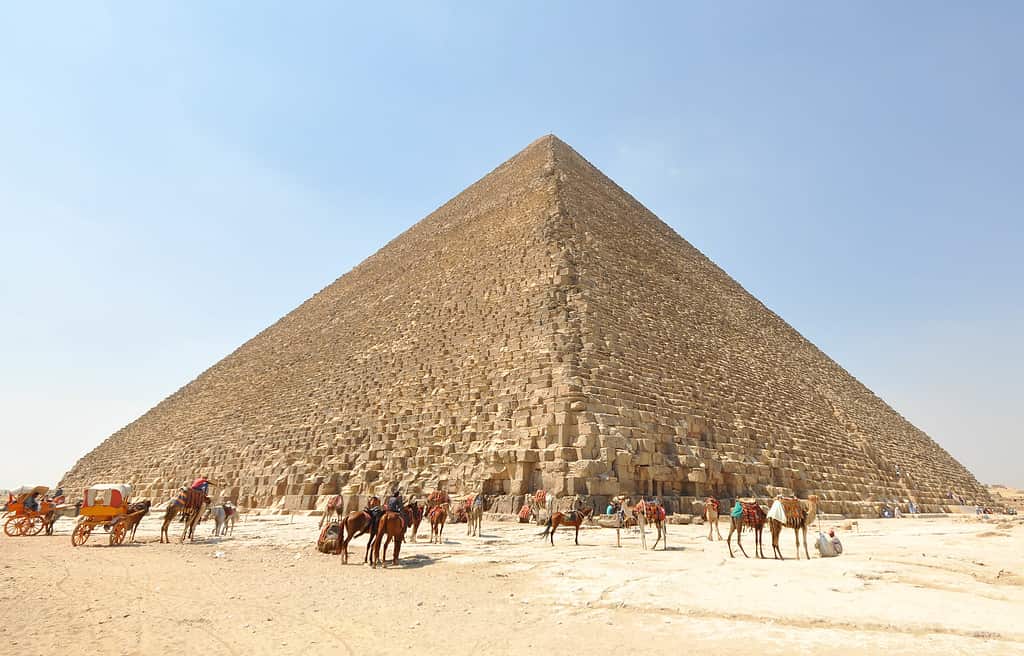
Height: 146 meters (481 ft)
Built in: early 26th century BC
Volume: 2.6 million cubic meters (92 million cubic feet)
Perhaps the most famous pyramids in the world, the Pyramids of Giza have been a marvel of engineering and construction for over 4,500 years. The largest of the three pyramids, the Great Pyramid of Khufu (or the Great Pyramid of Giza), was originally 146 meters (481 ft) tall and is estimated to have taken just about 30 years to build.
It is made up of over 2.3 million limestone blocks, each weighing between 2 and 70 tons. The precision of the construction is remarkable, with the sides of the pyramid aligned to the cardinal points of the compass with an accuracy within less than one degree.
The blocks were carved from nearby limestone quarries and transported to the site via a network of canals and ramps. The precision with which the blocks were cut and placed is still awe-inspiring, with each block fitting perfectly into place, even without mortar.
The sides and base of the Great Pyramid of Khufu are also aligned to the four cardinal directions — North, South, East, and West. Scholars don’t quite know exactly how the ancient Egyptians achieved this level of accuracy, but it is possible that they based this on the sun and the stars.
With this much craftsmanship involved in its construction, it is perhaps not all that surprising that Khufu is the oldest and sole remaining intact wonder of the Seven Wonders of the Ancient World.
Tourists are in awe of the Pyramids of Giza to this day, but one can only imagine what they looked like in their heyday. Thousands of years of erosion, wars, earthquakes, looting, and just bad management have taken their toll on these mighty pyramids.
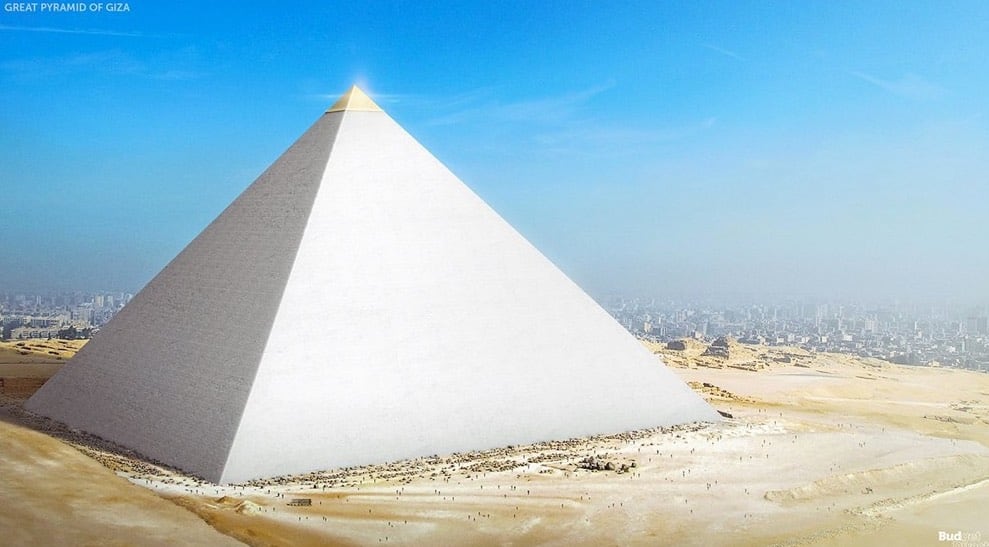
For instance, the Great Pyramid of Giza was once covered in a white casing made of glimmering limestone which was so polished that it would reflect the sun’s rays. Once the pyramid was completed, “it must have truly added to the impression of Giza as a magical port city, bathed in sunlight,” says archaeologist Mark Lehner in a clip for the Smithsonian, in which the production team digitally reconstructed what the Great Pyramid of Giza looked like in its moments of glory.
The Great Pyramid of Khafre – Egypt
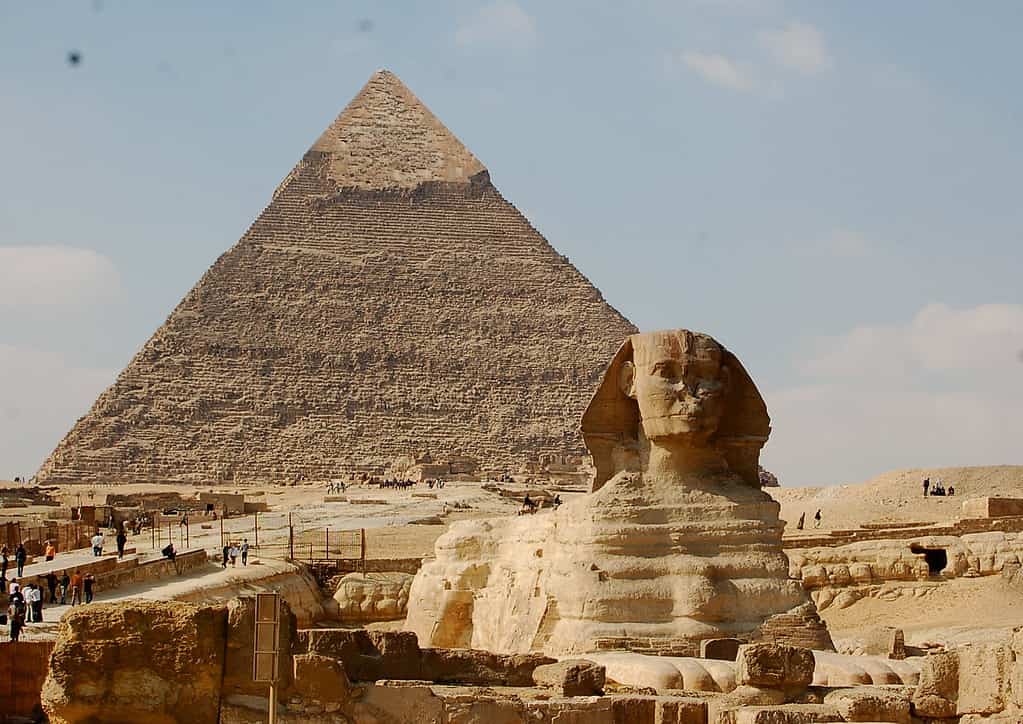
Height: 136 meters (448 ft)
Built in: mid-26th century BC
Volume: 2.2 million cubic meters (78 million cubic feet)
The Great Pyramid of Khafre, also known as the Pyramid of Chephren, is the second-largest of the three pyramids at Giza, and it remains one of the most impressive ancient structures in the world.
The Great Pyramid of Khafre was built as a tomb for the pharaoh Khafre, who ruled Egypt during the 26th century BC. Khafre was the son of Khufu, the pharaoh who commissioned the largest of the three pyramids at Giza. Although the Great Pyramid of Khafre is smaller than its neighbor, it is still an awe-inspiring sight, towering over the desert landscape.
The pyramid was constructed over a period of 20 years, and it was a massive undertaking that required the labor of thousands of workers. The limestone blocks were quarried from nearby sources, and then transported to the construction site using sledges and ramps. The workers then used a sophisticated system of levers and pulleys to lift the massive stones into place, creating the pyramid’s iconic shape.
While the exterior of the Great Pyramid of Khafre is impressive, the interior is just as fascinating. The pyramid has several chambers and passages, including a grand gallery that leads to the king’s chamber, where Khafre’s sarcophagus was placed. The chamber is made of red granite and is lined with inscriptions and hieroglyphics that tell the story of the pharaoh’s life and reign.
One of the most intriguing features of the pyramid is the so-called “air shafts,” which are narrow passages that extend from the king’s chamber to the exterior of the pyramid. These shafts were likely used for ventilation purposes, but their exact function remains a mystery to this day.
The Red Pyramid – Egypt
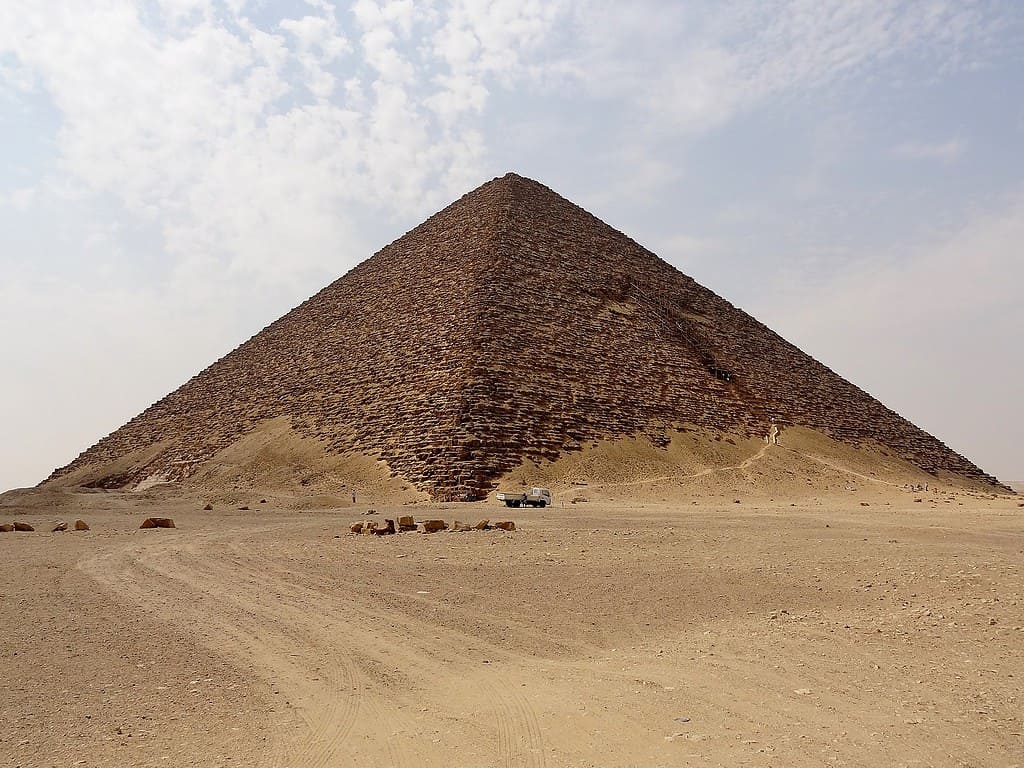
Height: 105 meters (344 ft)
Built in: mid-26th century BC
Volume: 1.69 million cubic meters (59 million cubic feet)
The Red Pyramid is the third largest pyramid in Egypt and the first true pyramid ever built. Prior to its construction, pyramids had a stepped design, like the famous Pyramid of Djoser. However, Pharaoh Sneferu wanted a smoother, more refined pyramid for his eternal resting place, and so the Red Pyramid was born.
Located in the Dahshur necropolis, about 25 miles south of Cairo, the Red Pyramid is so named because of the reddish limestone blocks used in its construction. It’s composed of an estimated 2.3 million limestone blocks, each weighing between 2 and 80 tons.
While the Red Pyramid was built as Sneferu’s final resting place, it is unclear why he chose this location for his pyramid. Some believe that it was due to the pyramid’s proximity to the ancient city of Memphis, while others believe that it was chosen because of its location in a sacred area associated with the god of the dead, Osiris.
The Red Pyramid has undergone extensive restoration and preservation efforts in recent years, including the installation of new lighting systems that allow visitors to explore the pyramid’s interior with greater clarity. This makes it a great place to visit among Egyptian pyramids, away from the busy traffic and tourist traps of Giza.
The Bent Pyramid of Giza – Egypt
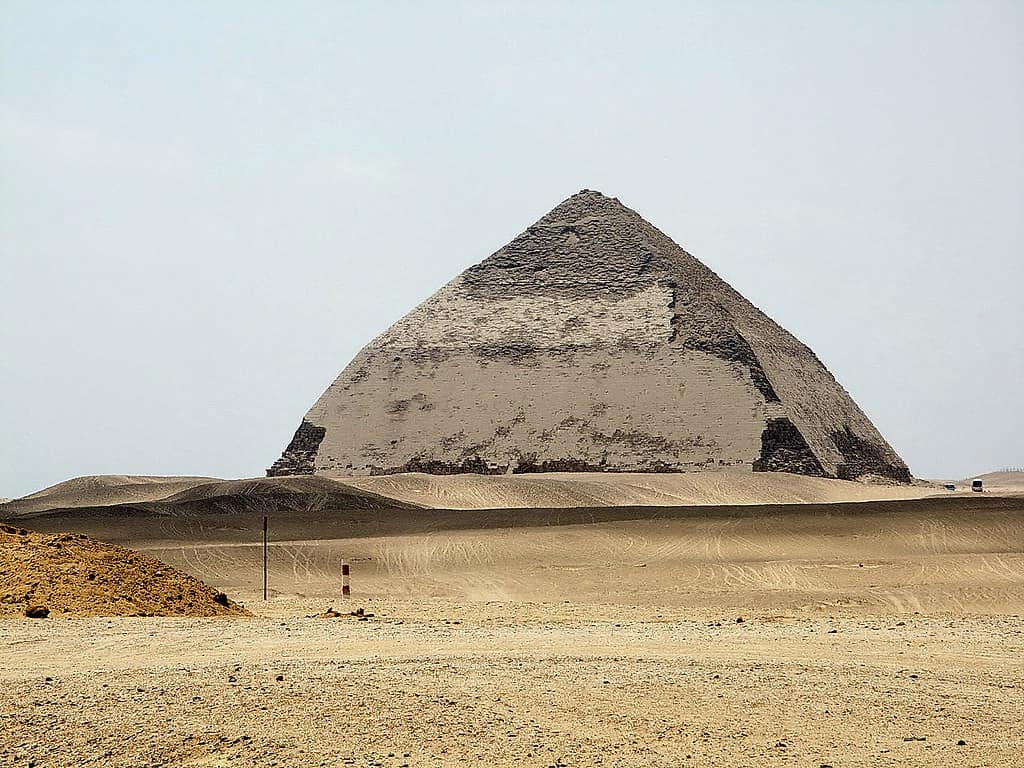
Height: 104 meters (344 ft)
Built in: early 27th century BC
Volume: 1.23 million cubic meters (43 million cubic feet)
The Bent Pyramid is located in the ancient necropolis of Dahshur, just south of Cairo. Built during the reign of Pharaoh Sneferu, the Bent Pyramid is believed to have been constructed around 2600 BC.
What sets it apart from other pyramids in Egypt is its unusual shape. The pyramid rises at a steep angle from the base, but, about halfway up, the angle changes, causing the pyramid to slope inward. This gives it a distinctive bent appearance and makes it unique among pyramids across the world.
The Bent Pyramid was not the first pyramid constructed during Sneferu’s reign. Prior to this, he had commissioned the construction of the Meidum Pyramid, which failed due to structural problems. It is believed that the Bent Pyramid was an attempt to rectify the mistakes made during the construction of the Meidum Pyramid.
Despite the extensive research conducted on the Bent Pyramid, many mysteries surrounding its construction and purpose still remain. One of the most intriguing questions is why the angle of the pyramid changes halfway up. Some theories suggest that the architects may have encountered structural problems, causing them to modify the design. Others speculate that the change in angle may have been intentional, to reduce the weight of the upper section of the pyramid.
Another mystery surrounding the Bent Pyramid is the absence of any inscriptions or markings on its walls. Unlike other pyramids in Egypt, the Bent Pyramid does not contain any hieroglyphs or other forms of writing. This has led some experts to believe that the pyramid was never actually used as a tomb.
The Pyramid of the Sun – Mexico

Height: 65 meters (216 ft)
Built in: 200 AD (abandoned in 750 AD)
Volume: 1.18 million cubic meters (41.8 million cubic feet)
Located just outside of Mexico City, the ancient city of Teotihuacan was one of the largest and most influential cultural centers of pre-Columbian Mesoamerica. At its peak, it was home to over 100,000 people and covered an area of nearly 20 square kilometers. But the most impressive aspect of Teotihuacan is undoubtedly its monumental pyramids, which dominate the landscape and inspire awe in all who behold them.
The Pyramid of the Sun, the largest of Teotihuacan’s pyramids, stands an incredible 65 meters tall and covers an area of over 22,000 square meters. Constructed between 100 and 200 AD, it was originally covered in stucco and painted in vibrant colors, making it even more imposing and impressive. The Pyramid of the Moon, slightly smaller but no less impressive, stands at the northern end of the Avenue of the Dead and is thought to have been used for ritual and ceremonial purposes.
But the true wonder of Teotihuacan’s pyramids lies not just in their size, but in the engineering and architectural genius that went into their construction. The builders of Teotihuacan did not have access to the advanced tools and technology of modern times (they didn’t even use the wheel and seldom wrote script), yet they were able to create structures that have stood the test of time and weathered centuries of earthquakes, erosion, and human activity.
Scholars believe that the temple would also have served ritualistic and symbolic purposes. Researchers tunneled through the base of the pyramid from 2008 to 2010, discovering a number of ritual offerings, including an eagle with a pyrite disk on its back. This symbol would appear centuries later in Aztec iconography showing an eagle carrying the world on its back. The Aztecs inherited Teotihuacan but it’s still unclear who were the original builders of this monumental temple system.
La Danta – Guatemala
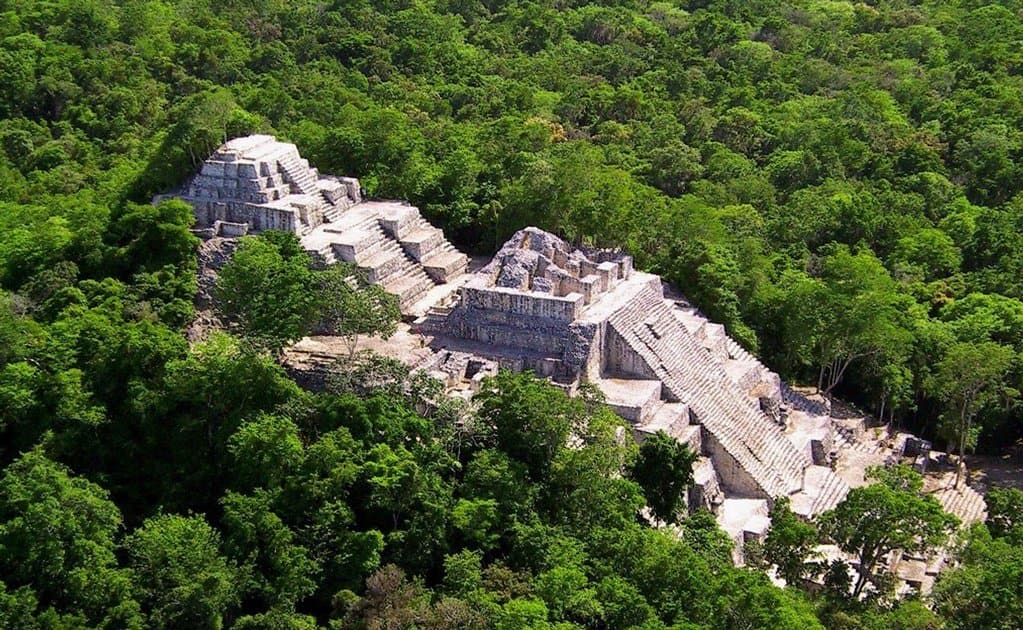
Height: 72 meters (236 ft)
Built in: 900 – 300 BC
Volume: 2.8 million cubic meters (99 million cubic feet)
Deep in the heart of the Guatemalan jungle, shrouded by the dense foliage of the Petén Basin, lies one of the greatest architectural achievements of the ancient Maya civilization: La Danta temple. Rising over 72 meters (236 feet) into the sky, this awe-inspiring structure is a testament to the ingenuity and skill of the people who built it.
La Danta temple was constructed between 900 and 300 BC, during the height of the Maya civilization’s power. It is located in the ancient city of El Mirador, which was one of the largest and most influential cities of the Maya world. At its peak, El Mirador was home to an estimated 200,000 people, and its towering structures dominated the surrounding landscape.
The construction of La Danta temple was a monumental undertaking. The temple was built in a stepped pyramid shape, with nine levels that were carefully designed to align with the cycles of the sun and moon. The outer walls of the temple were covered in intricate carvings and stucco decorations, depicting scenes from Maya mythology and history.
The base of the pyramid measures 230 meters (755 feet) on each side, making it one of the largest structures of its kind in the world. The temple was constructed using an estimated 15 million cubic feet of stone and earth, which was transported to the site by an army of workers using only rudimentary tools and techniques.
Despite its impressive size and complexity, La Danta temple was abandoned by the Maya people around 900 CE, and the city of El Mirador was eventually lost to the jungle. For centuries, the temple lay hidden beneath a layer of dense vegetation, its true scale and grandeur unknown to the outside world.
The Maoling Mausoleum – China

Height: 46 meters (150 ft)
Built in: 89 BC
Volume: 2.8 million cubic meters (99 million cubic feet)
Among the lush green hills of China’s Shaanxi Province lies a hidden ancient wonder of the world: the Maoling Mausoleum. Built over 2,000 years ago, this monumental tomb is a testament to the power and grandeur of the Han Dynasty.
The Maoling Mausoleum was built for Emperor Wu, who ruled China from 141 to 87 BC. Wu was one of the most influential and successful emperors in Chinese history, and his reign was marked by a period of prosperity and expansion. To commemorate his achievements, he commissioned the construction of an extravagant tomb that would befit his status as one of the greatest rulers of China.
The mausoleum is a vast complex that covers an area of over 46,000 square meters. It is surrounded by a massive earthen wall, which is over 6 meters high and more than 2,400 meters in circumference. Inside the wall, there are numerous buildings, temples, and pavilions, all of which were constructed with the finest materials and decorated with intricate carvings and paintings.
At the heart of the complex lies the tomb itself, which is the largest and most impressive structure in the mausoleum. The tomb is a massive earthen mound that rises to a height of over 40 meters and has the shape of a pyramid with its tip cut off. It is surrounded by a moat and several layers of walls and gates, which were designed to protect the tomb from intruders and tomb raiders.
The world’s largest and most amazing pyramids are not only awe-inspiring in their size and architecture but also offer a glimpse into the cultural and technological advancements of ancient civilizations. These incredible structures have stood the test of time and continue to fascinate us with their mystery and beauty.
As we stand in the shadow of these incredible monuments, we are reminded of the enduring legacy of human ingenuity and the wonders of the ancient world.


